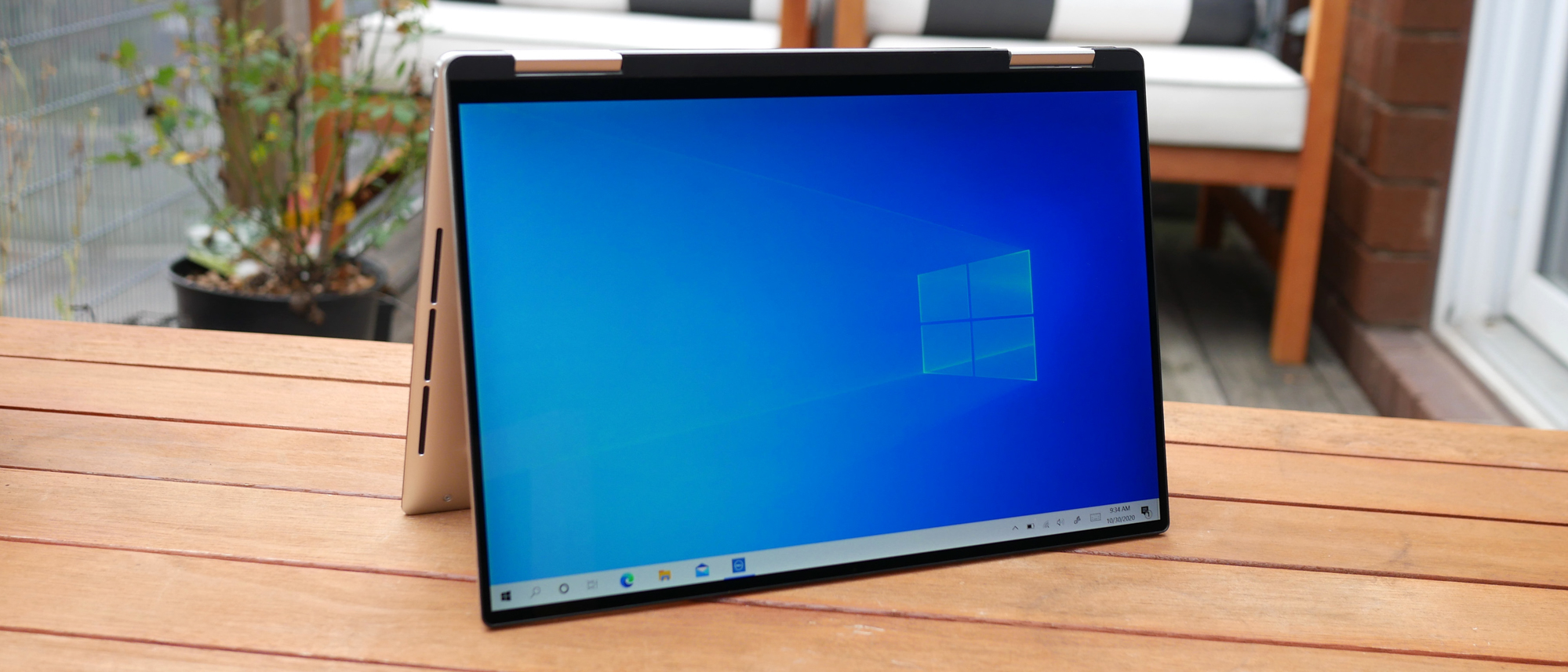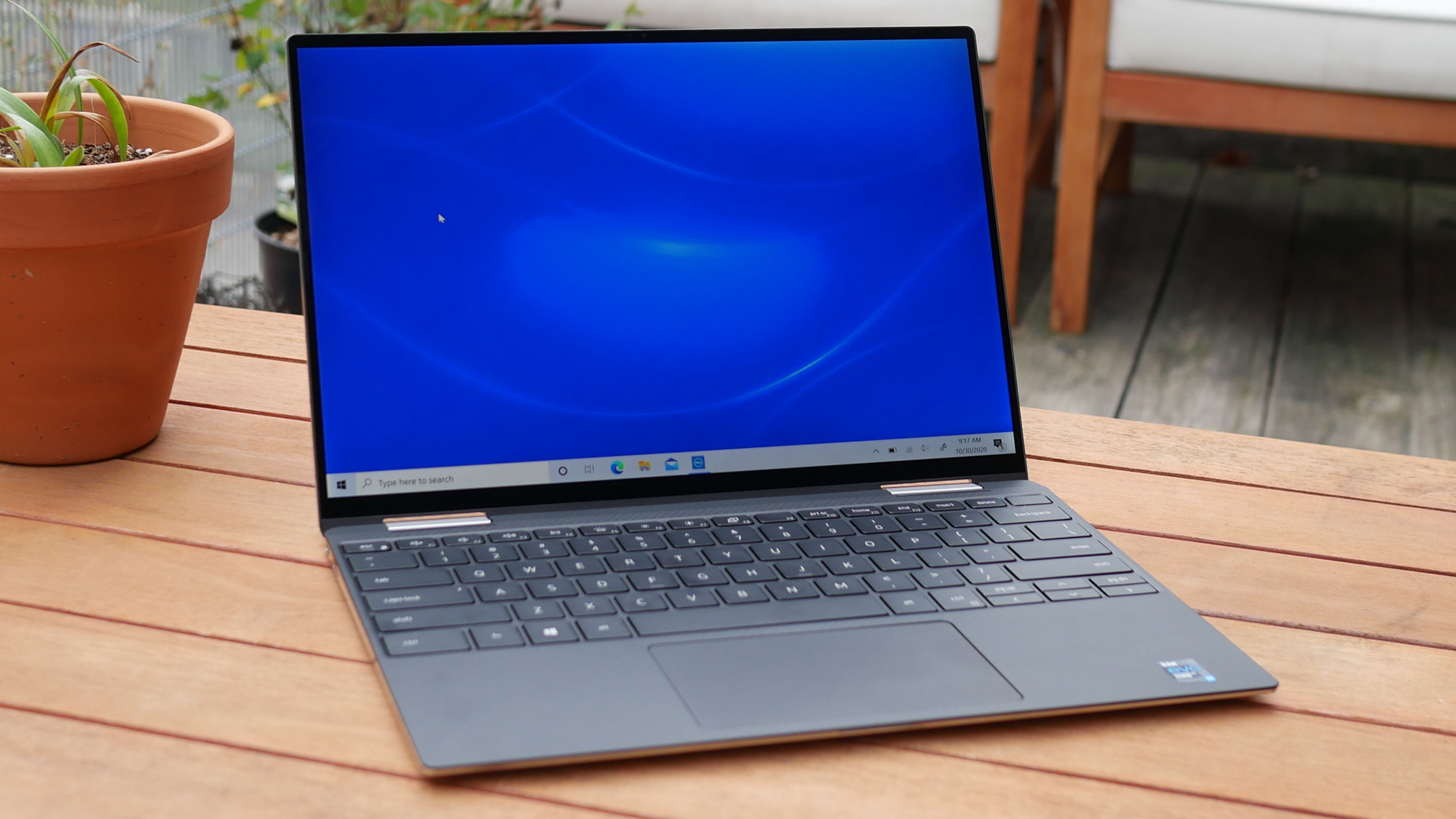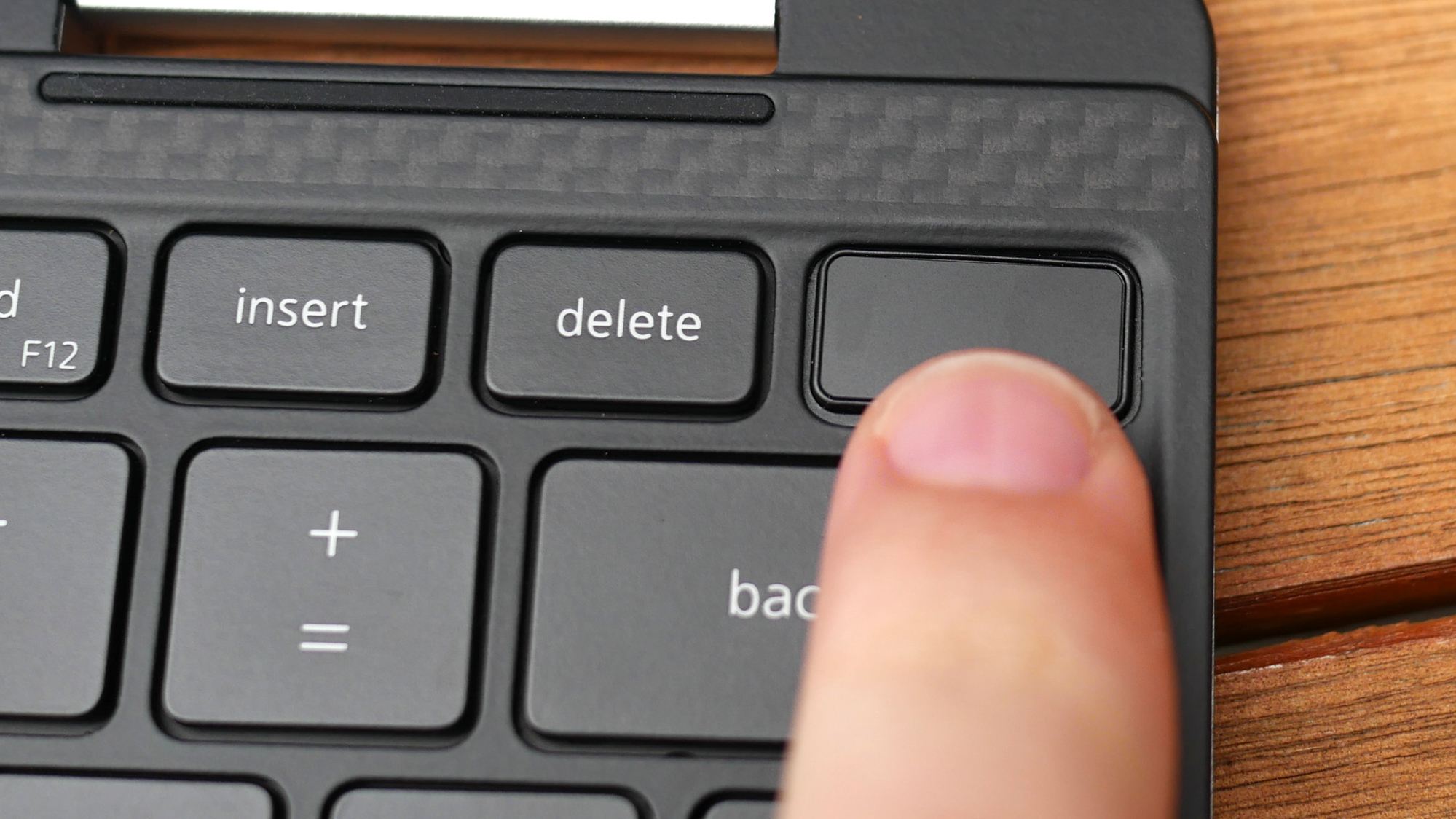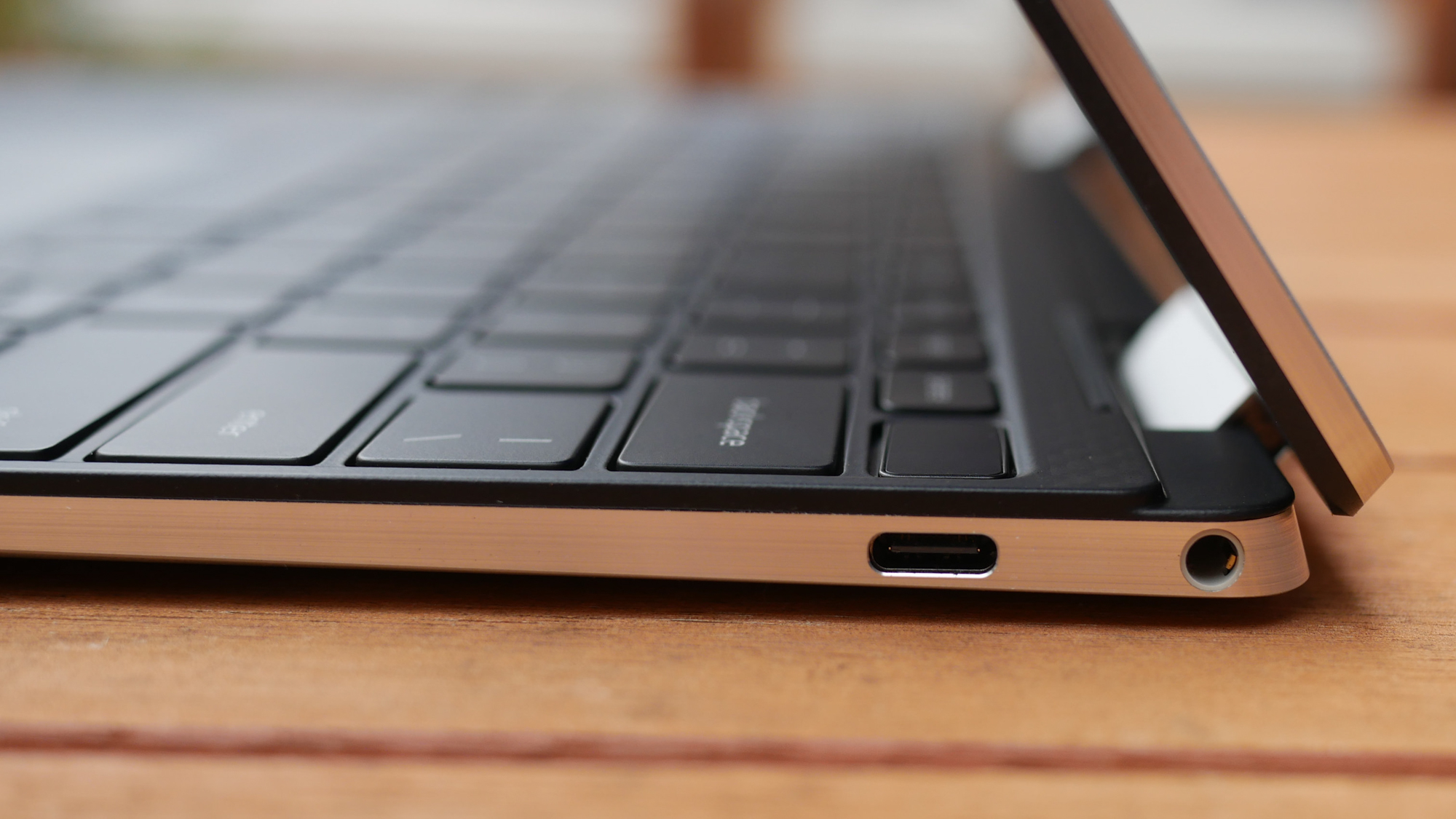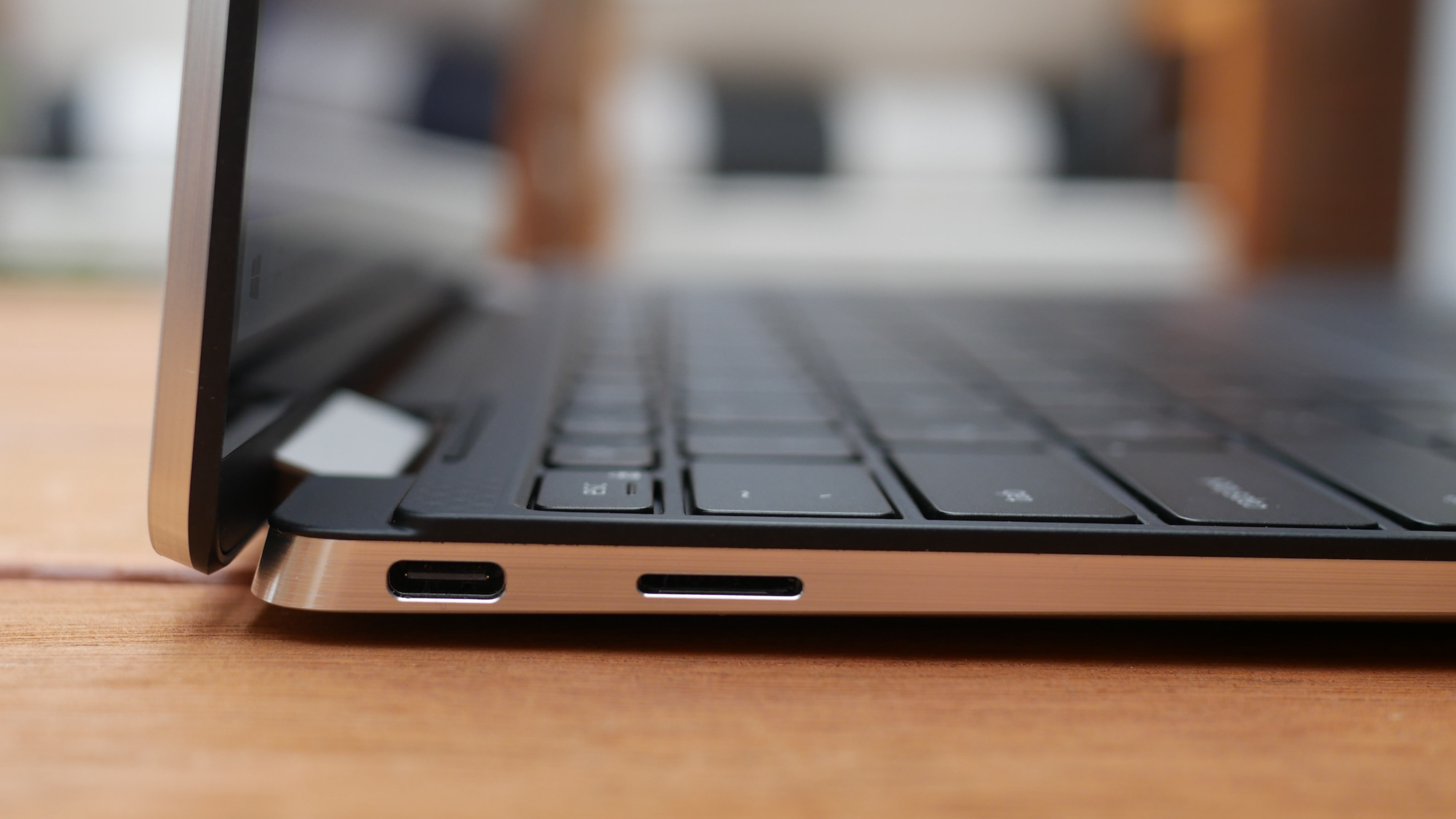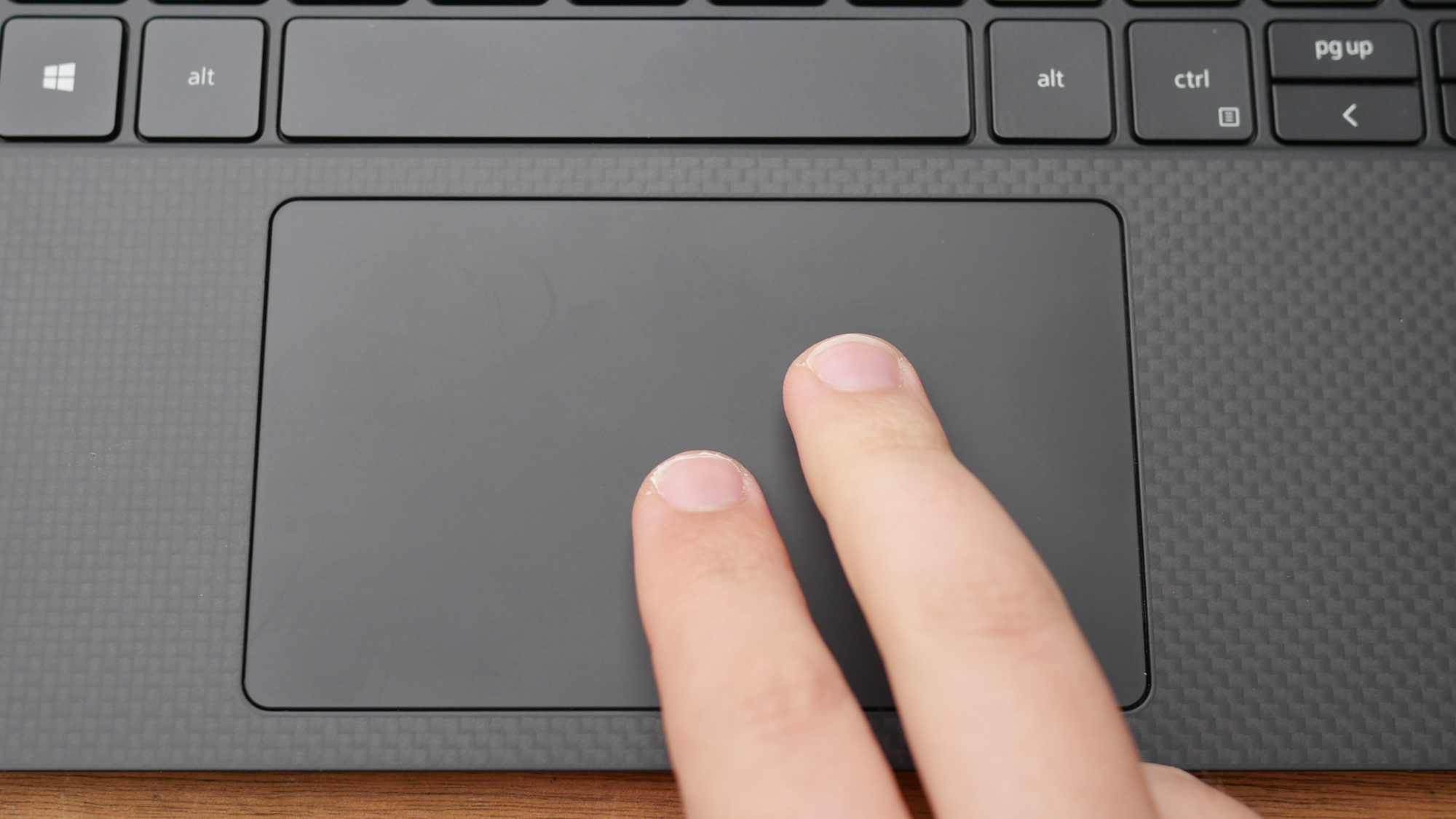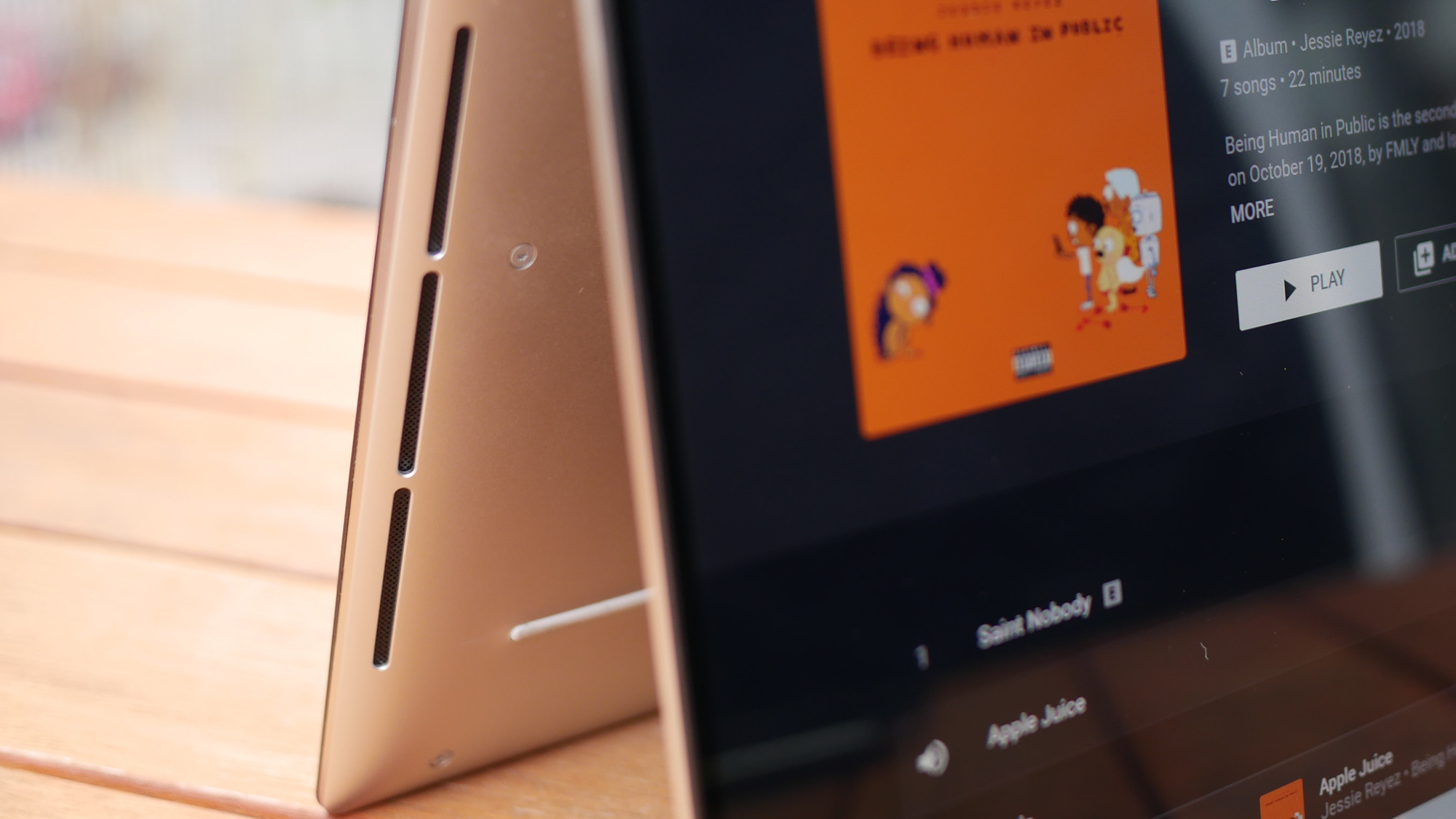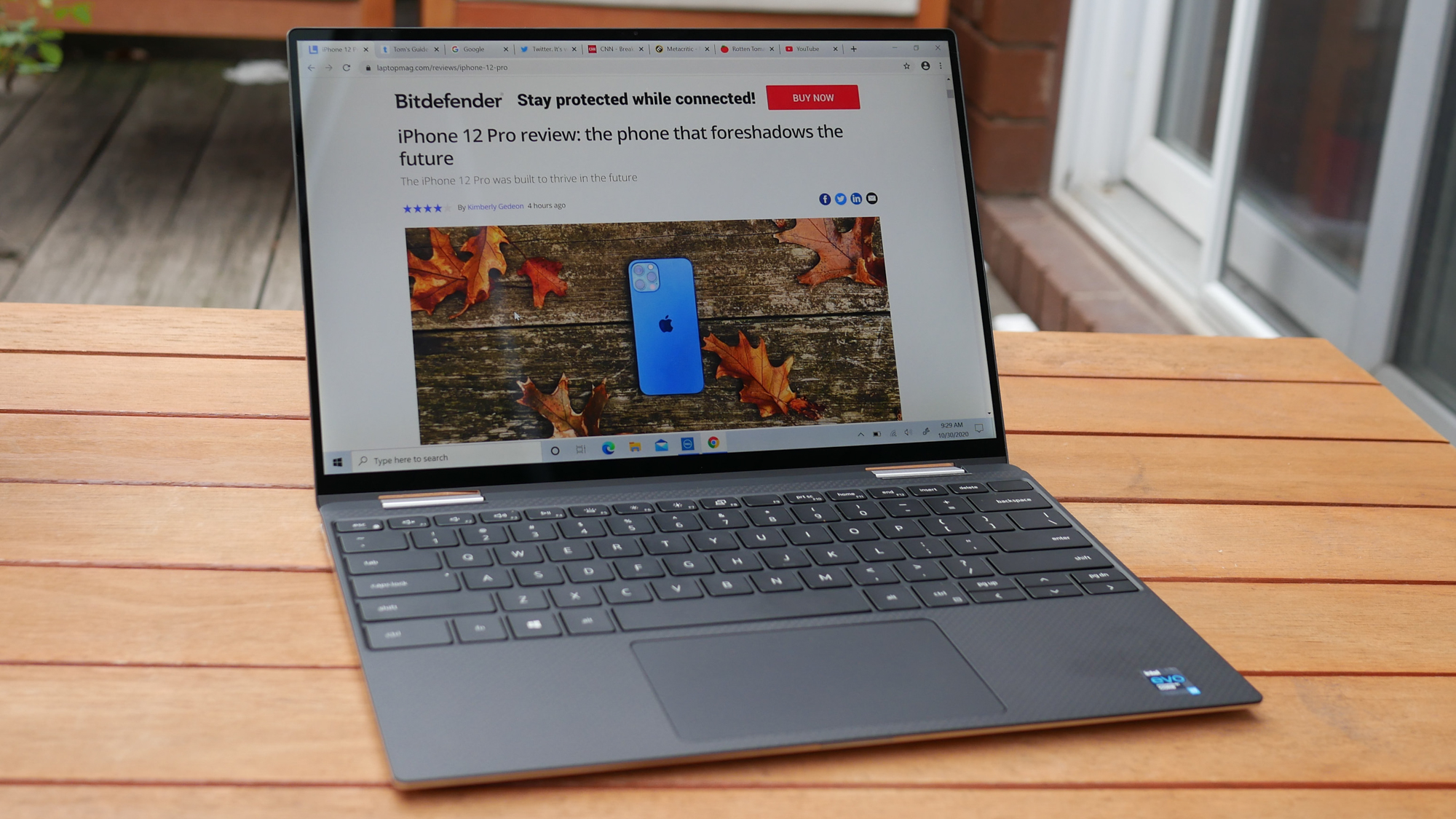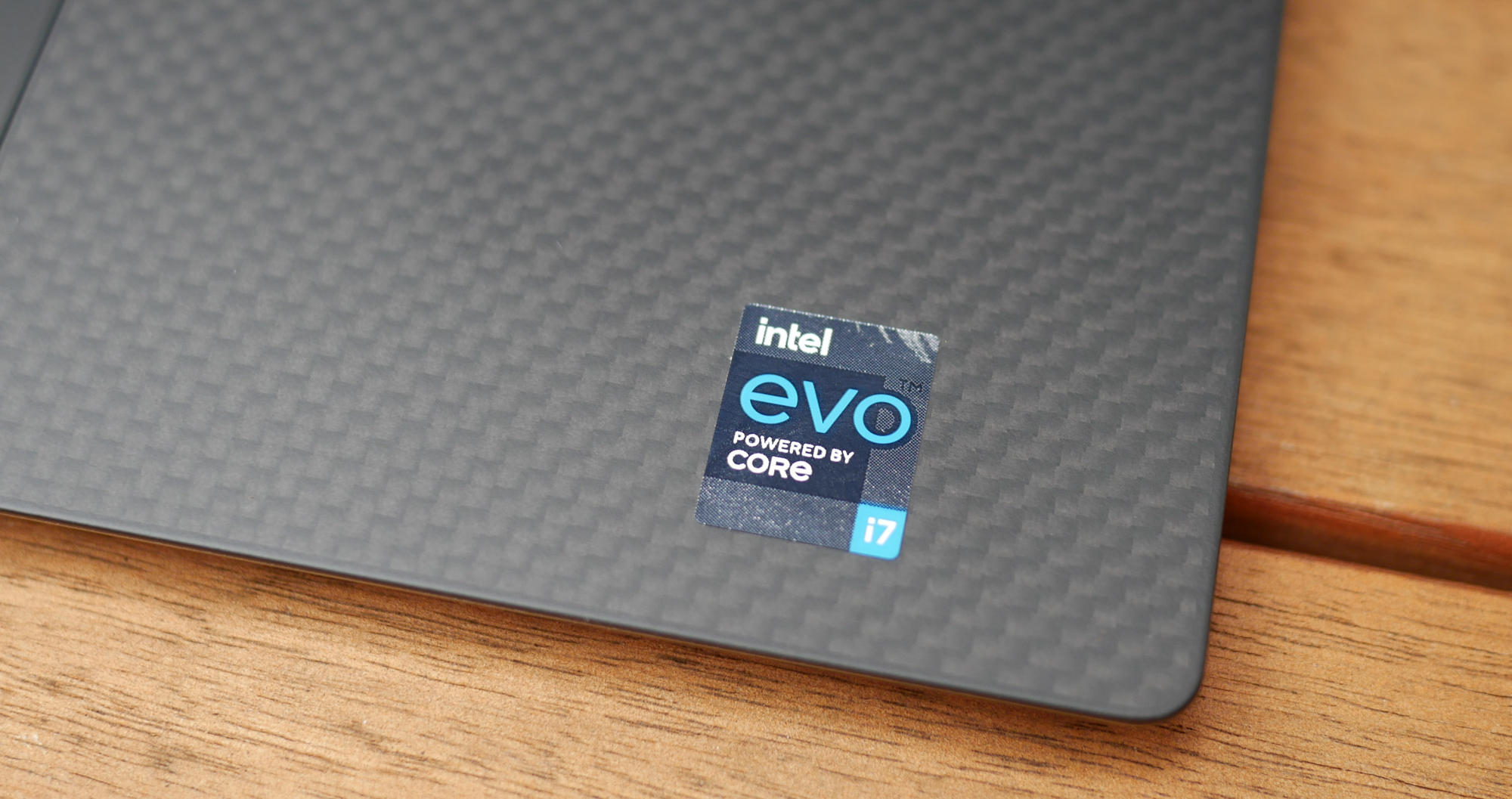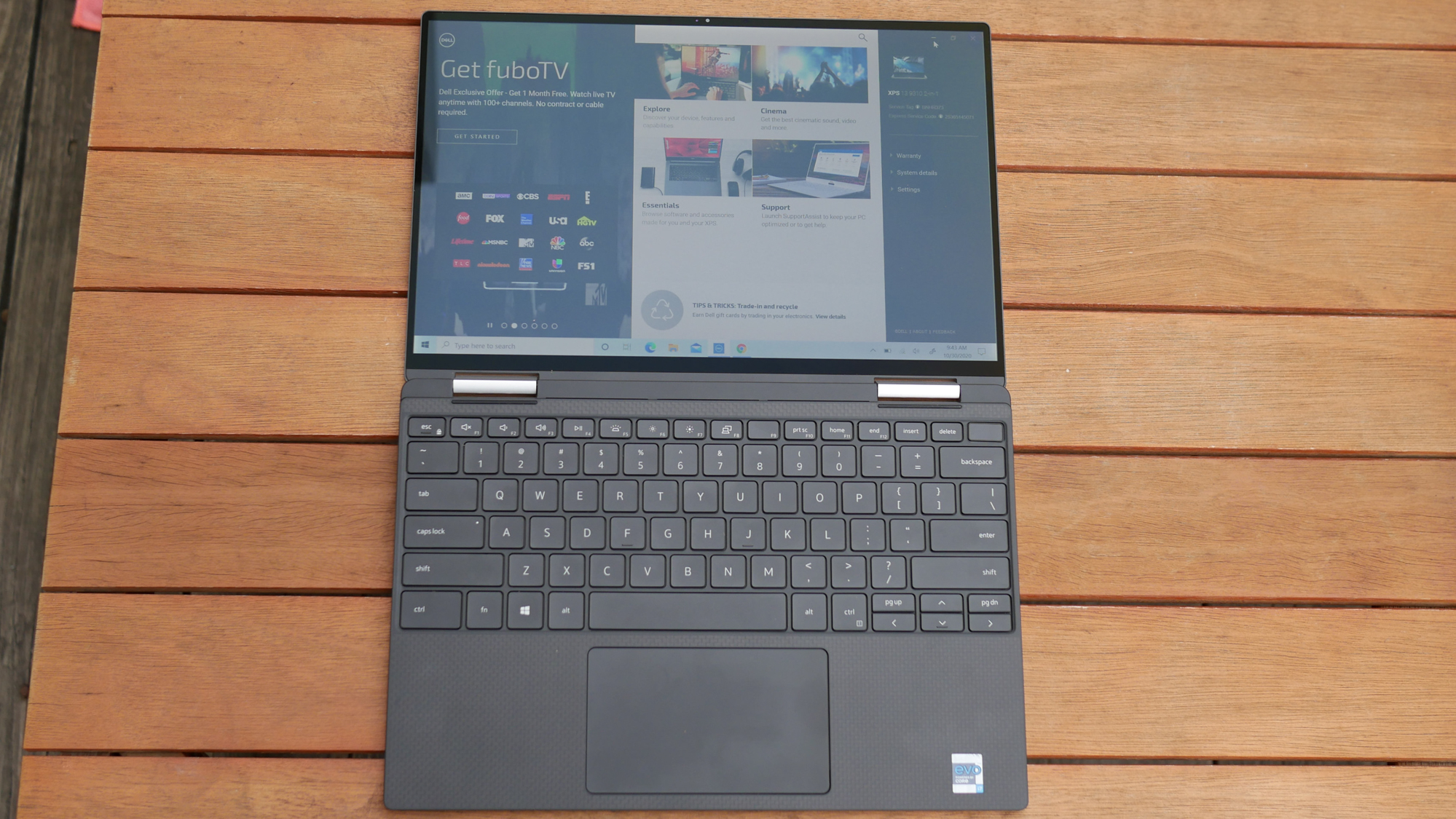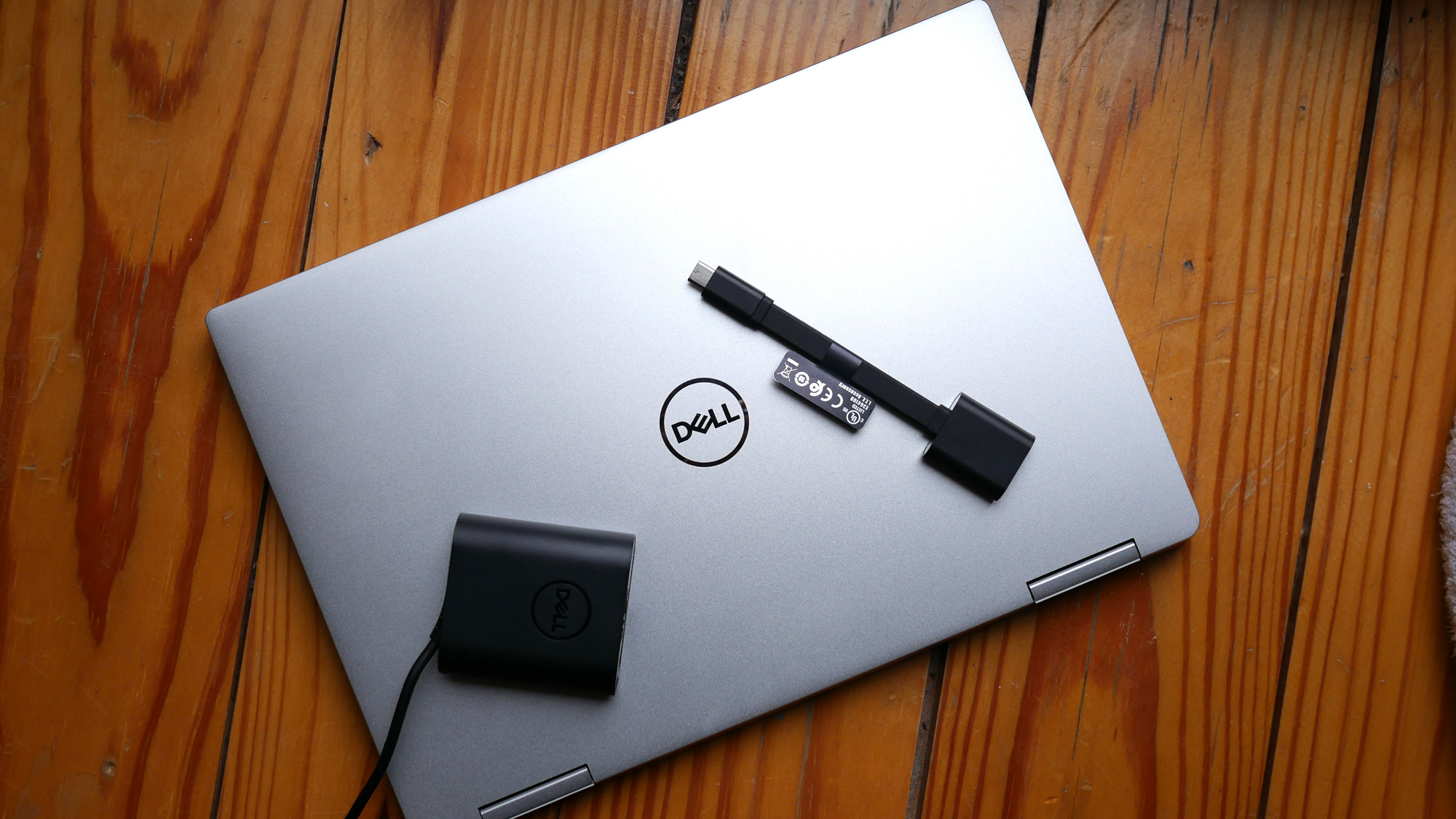Laptop Mag Verdict
Dell's XPS 13 2-in-1 brings Intel 11th Gen brawn to a fantastic convertible that flaunts a premium, ultrathin design, long battery life and a bright display.
Pros
- +
Slim, attractive design
- +
Top-rate build quality
- +
Bright 13.4-inch display
- +
Long battery life
- +
Fast Intel 11th Gen CPUs
Cons
- -
Shallow keyboard isn't for everyone
- -
Display could be more colorful
- -
No USB-A ports
Why you can trust Laptop Mag
Price: $1,617
CPU: Intel Core i7-1165G7
GPU: Iris Xe
RAM: 16GB
Storage: 512GB
Display: 13.4-inch, 1920 x 1200-pixels (touch)
Battery: 10:52
Size: 11.6 x 7.8 x 0.6 inches
Weight: 2.9 pounds
The Dell XPS 13 is the best laptop on the market, but its success has caused the XPS 13 2-in-1 to be somewhat overshadowed. It doesn't help that early versions of the laptop/tablet hybrid suffered from poor battery life and a clunky chassis. The 2020 model, however, should help the XPS 13 2-in-1 step out of the shadows of its sibling and into the spotlight.
The new XPS 13 2-in-1 is without question among the best 2-in-1 laptops you can buy. That shouldn't come as a surprise. Dell smartly used the XPS 13 as a blueprint for the XPS 13 2-in-1, an almost identical laptop, but with the ability to transform into a tablet.
New features to this year's edition make the XPS 13 2-in-1 more appealing than before. Intel's 11th Gen Tiger Lake CPUs with Iris Xe Graphics deliver a solid performance and graphics boost from the previous chips. The XPS 13 2-in-1 also received a quality-of-life improvement in the way of an IR camera, so you can stop typing in passwords. And although the design is unchanged, a new Frost lid matches the white color option.
There are still a few shortcomings you should consider before buying the XPS 13 2-in-1, like its shallow keyboard and lack of legacy ports. However, with a bright 13.4-inch screen, long battery life and stunning design, the XPS 13 2-in-1 makes it hard for us to recommend anything else.
Dell XPS 13 2-in-1: Price and configuration options
The XPS 13 2-in-1 starts at $1,078 for a base model with an Intel 11th Gen Core i3-1115G4 CPU, 8GB of RAM and a 256GB SSD.
We recommend upgrading to a Core i5-1135G7 model, which gets you Iris Xe Graphics for $1,225. I would personally spend $1,421 to double RAM to 16GB and storage to 512GB SSD if your budget allows for those upgrades. Our $1,617 review unit has those same specs but uses an upgraded Core i7-1165G7 CPU.
Photo and video editors needing the best picture can spend $1,912 on a 4K model with a Core i7-1165G7 CPU, 16GB of RAM and a 1TB SSD. Alternatively, you can customize the aforementioned models to have a 4K display, but it'll cost you an extra $294.
Sign up to receive The Snapshot, a free special dispatch from Laptop Mag, in your inbox.
Splurging on the top-end model will set you back $2,205 but the upgrades include a 4K display, a Core i7-1165G7 CPU (with Iris Xe graphics), 32GB of RAM and a 1TB PCIe NVMe SSD.
Dell XPS 13 2-in-1: Design
The XPS 13 2-in-1 was given a full-blown makeover last year. This year, it receives some makeup and a few accessories.
Almost identical to the previous model, the XPS 13 2-in-1 has a sleek aluminum design with modern elements. You don't get the four-sided bezels on the clamshell model, but the convertible still has thin display borders, resulting in a screen-to-body ratio of 84.9%.
The build quality is superb. Dell took painstaking measures to make the XPS 13 2-in-1 feel as premium as it looks. To that end, the XPS is CNC cut from two blocks of aluminum then bonded with Corning Gorilla Glass 6 for extra durability. Diamond-cut edges with a brushed finish give the convertible luxurious accents and the chrome Dell logo on the lid mirrors XPS branding underneath.
The only change made to the 2020 edition is a new Frost aluminum lid, which compliments the Arctic White palm rest better than the previous Platinum Silver tone. If only wish Dell had sent me that color so I could marvel at the contrast. Fortunately, I've seen the Frost lid in person on the XPS 13, and it's gorgeous.
And let me ease any fears from you neatniks out there; the interior surfaces are covered in a stain-resistant coating to prevent them from yellowing or staining. I don't dare test this with my morning Starbucks but the lack of complaints online is reassuring. Traditionalists can opt for the Platinum Silver model with a black carbon fiber palm rest. It looks stylish, if a bit stale.
Of course, the main advantage the XPS 13 2-in-1 has over its clamshell sibling is the ability to convert into a tablet. You can also position the laptop in tent mode or fold the keyboard away when you're watching shows and movies. The hinge has just the right amount of resistance; the screen doesn't wobble when I tap on it yet rotating the display back doesn't take much effort.
What impressed me most about the XPS 13 2-in-1's design is how thin the base is. It is nearly the same thickness as the lid. As a result, the convertible is only 11.6 x 7.8 x 0.6 inches and 2.9 pounds, which is thinner (but slightly heavier) than the HP Spectre x360 13 (12.1 x 7.7 x 0.7 inches, 2.7 pounds) and more compact than the Lenovo Yoga C940 (12.6 x 8.5 x 0.7 inches, 3 pounds). Its clamshell sibling, the Dell XPS 13, has an even smaller footprint (11.6 x 7.8 x 0.6 inches, 2.8 pounds).
Dell XPS 13 2-in-1: Security
On the carbon-fiber deck is a fingerprint sensor embedded in the top-right corner of the keyboard underneath a pair of silver hinges.
Along with the new IR camera, the fingerprint scanner makes logging into the XPS 13 2-in-1 quicker and easier than ever before. Neither the IR camera nor fingerprint sensor were 100% reliable, but between the two of them, I was signed into the laptop quicker than I could type my password.
Dell XPS 13 2-in-1: Ports
No bezels equals fewer ports. This calculation almost always proves true and it certainly does with the XPS 13 2-in-1.
On the right side of the laptop are a Thunderbolt 4 port and a headphone jack. Flip over to the left side and you'll find a second Thunderbolt 4 input alongside a MicroSD card slot. It doesn't replace having on-board legacy ports, but Dell does include a USB-C-to-USB-A dongle in the box.
I know, another charging input to add to the long and confusing list. This one isn't so bad. In short, Thunderbolt 4 is identical to Thunderbolt 3 except that it supports two 4K monitors and at least one port must be used for charging thin-and-lightweight laptops. Maximum data transfer speeds remain at 40GBps but can now be achieved using a 2 meter-long cable.
Dell XPS 13 2-in-1: Display
You can upgrade to a 4K screen, but I'm perfectly happy with the 13.4-inch, 1920 x 1200-pixel panel on our XPS 13 2-in-1 unit.
The FHD+ screen with a 16:10 aspect ratio looks great. Although it isn't the most colorful on paper, my eyes feasted on a vibrant, crisp and bright panel as I watched videos and browsed the web. The screen is so sharp that I could see each cigarette butt sticking out of the mouth of a skeleton in the trailer for The Kings Man. Even the grain of the darkened wood bunker panels was visible in a freeze frame. The colors were also rich; each of the commander's ribbons popped off his dark uniform and the golden Aiguillette trimmed his attire.
Our lab results surprised me. According to our colorimeter, the XPS 13 2-in-1's display covers only 70% of the DCI-P3color gamut, making it less vivid than the panels on the Spectre x360 13 (77%), Yoga C940 (74%), XPS 13 (81%) and the premium laptop average (83%).
That doesn't tell the whole story. The XPS 13 2-in-1 rebounded by outshining the competition with a peak brightness of 488 nits. The XPS 13 was the closest, hitting 471 nits, while the Spectre x360 (369 nits) and Yoga C940 (339 nits) weren't nearly as bright. The premium laptop average is 386 nits.
Dell XPS 13 2-in-1: Keyboard and touchpad
Oh no, I'm getting flashbacks of typing on Apple's doomed Butterfly keyboard.
Unlike the traditional keys on the XPS 13, the XPS 13 2-in-1 has a Maglev keyboard that feels eerily similar to the now-extinct Butterfly keyboard. The keys have practically no travel — they barely descend before actuating, which creates the feeling of tapping on a flat surface. Bottoming out is inevitable and these magnet-driven keys are rather loud compared to traditional spring-operated ones.
While not the most comfortable to type on, the backlit keyboard spans from one edge of the deck to the other, resulting in keys that are large enough for big hands. My chubby sausage fingers never hit more than one key at a time, and the wide spacing between each letter helped with accuracy.
The generous spacing also prevented me from tapping the power button inconveniently positioned in the top-right corner of the keyboard. Why so much hatred with this placement? I will direct you to my rant on power button positioning before I get heated.
As a speedy typer, I appreciate how little force is needed to actuate each key. I typed at 114 words per minute with a 96% accuracy on the 10fastfingers.com typing test, which is about as fast and accurate as my usual 119-wpm at 95% accuracy averages.
The comfort of a keyboard is subjective. I prefer keys with more travel and springier feedback than those on the XPS 13 2-in-1. The keyboard is fine for when you're traveling, but I'd switch to a proper gaming keyboard or a wireless solution (like Lenovo's ThinkPad TrackPoint Keyboard II) in the office or at home.
The massive 4.4 x 2.6-inch touchpad is one of the best I've used. The silky surface feels great against my fingers, and it quickly executed Windows 10 gestures, like three-finger swipe to switch apps and two-finger scrolling.
Dell doesn't include a stylus with the XPS 13 2-in-1 so you'll need to spend an extra $99 on the Premium Active Pen to get the most out of the touchscreen.
Dell XPS 13 2-in-1: Audio
The stereo speakers on the XPS 13 2-in-1 push sound out from grilles in the sides of the chassis. As a result, your mileage will vary based on how the laptop is positioned.
As a clamshell laptop, the dual speakers were loud enough to be heard throughout my townhouse. But when I listened to Jessie Reyez's "Apple Juice" in laptop mode on a desk, the vocals were slightly muffled and the treble sounded sharp. Flipping the laptop into tent mode improved the audio considerably; the midrange was more crisp and the subtle bass sounded refined.
The sound certainly isn't bad in clamshell mode but it goes from fine to very good when music isn't being absorbed by a surface.
Dell XPS 13 2-in-1: Performance
An Intel EVO-certified laptop, the XPS 13 2-in-1 is armed with 11th Gen (Tiger lake) Intel Core processors and Iris Xe graphics. Our review unit, outfitted with an Intel Core i7-1165G7 CPU and 16GB of RAM, handled a heavy workload with ease.
I loaded 20 Google Chrome tabs, which included my favorite tech websites along with more demanding pages, like YouTube and Twitch. Despite multiple videos and streams playing simultaneously, the XPS 13 2-in-1 had no problems launching new pages with photos and graphics rendering almost instantly.
The XPS 13 2-in-1 impressed on our benchmark tests, crushing the competition in most categories thanks to the new 11th Gen chips. On the Geekbench 5 overall performance test, the XPS 13 2-in-1 scored a 5,571, which is significantly more than what the Spectre x360 13 (4,074, Core i7-1065G7), Yoga C940 (4,074, Core i7-1065G7) achieved, and a notch above the XPS 13 (5,254, Core i7-1165G7). The category average on this test is 4,115.
It took 15 minutes and 52 seconds for the XPS 13 2-in-1 to convert a 4K video to 1080p resolution using the Handbrake app. The XPS 13 (15:40) crossed the finish line a few seconds earlier but the Yoga C940 (19:32), Spectre x360 13 (21:13) and the average premium laptop (18:14) needed more time.
With a score of 659 on the Puget Photoshop benchmark, the XPS 13 2-in-1 topped the XPS 13 (588) and the category average (606).
The 512GB PCIe NVMe x4 SSD in the XPS 13 2-in-1 duplicated a 5GB multimedia file in 10 seconds for a transfer rate of 503.1 megabytes per second. That is quicker than the Spectre x360 13 (318.1 MBps, 512GB M.2 PCIe NVMe SSD) and the Yoga C940 (391.5 MBps, 512GB PCIe SSD) but a few paces behind the XPS 13 (642.5 MBps, 512GB M.2 PCie NVME SSD) and the 568.5 MBps category average.
Dell XPS 13 2-in-1: Graphics
This is a new era for integrated graphics. Previously only capable of playing less graphics-intensive titles at low frame rates, the new Iris Xe graphics are hyped by Intel to run some AAA games.
Unfortunately, our graphics benchmarks tell a different tale. The XPS 13 2-in-1 played Sid Meier's Civilization VI: Gathering Storm at 21 frames per second, which is better than the XPS 13 (16 fps, Iris Xe) but short of the category average (27 fps) and our 30-fps playability threshold.
Our synthetic benchmarks tell a more promising story. The XPS 13 2-in-1 hit 3,847 on the 3DMark Fire Strike test, topping the Spectre x360 13 (2,615, Iris Plus), Yoga C940 (2,138, Iris Plus), and XPS 13 (3,598) but falling short of the category average (5,393), which is inflated with scores from laptops with discrete GPUs.
Dell XPS 13 2-in-1: Battery life
Our primary complaint with the original XPS 13 2-in-1 was that its battery life lagged behind the competition. When Dell relaunched the convertible after a lengthy hiatus, the runtime issue had been properly addressed.
The newest XPS 13 2-in-1 doesn't move the needle, and that's OK. The laptop endured for 10 hours and 52 minutes on the Laptop Mag battery test (continuous web surfing over Wi-Fi at 150 nits), powering off 5 minutes before the 2019 model.
The competition is fierce in this area so before making comparisons, I want to reiterate: 10:52 is an excellent runtime. That being said, the Spectre x360 13 (13:20), Yoga C940 (11:46) and XPS 13 (12:39) all outendured the XPS 13 2-in-1 even though it added an extra hour to the premium laptop average (9:52).
Dell XPS 13 2-in-1: Webcam
The miniature (2.25-millimeter) 720p webcam located on the narrow bezels above the display takes grainy photos and videos.
A selfie I snapped in my office was colorful but my disheveled beard was a collective brown blob instead of a nest of individual hair strands. The burnt-orange color in my Texas Longhorns hat would have made Bevo (our mascot) proud and I could make out the brown-to-transparent gradient in the frame of my glasses.
I went outside on an overcast day, but the sunlight streaking through the clouds didn't expunge the visual noise completely. I could see more details, like creases around my eyes, but the graininess remained. The photo wasn't helped by the overexposed sky, which blended in with the top of my gray hat.
My advice? Buy one of the best external webcams, like the Logitech HD Pro C920, once they go back in stock if you Skype, Zoom or Hangouts regularly.
Dell XPS 13 2-in-1: Heat
Overheating can be an issue for ultrathin laptops, especially those made of metal. Fortunately, the XPS 13 2-in-1 has sufficient cooling even under a heavy workload.
After playing a 15-minute, Full HD video in full-screen, the hottest part of the laptop, on the deck near the PrtSc key, warmed to only 92 degrees Fahrenheit, a few degrees below our comfort threshold. You won't have problems typing or using the cursor as the keyboard peaked at 81 degrees and the touchpad reached 75 degrees. With the underside reaching 88 degrees, you can use the XPS 13 2-in-1 on your bare lap without any red marks forming.
Dell XPS 13 2-in-1: Software and warranty
Dell doesn't package its pre-installed software into one app as some vendors thankfully do, but it doesn't overwhelm the XPS 13 2-in-1 with bloatware, either. And actually, most of what's here is useful.
Dell CinemaColor, for example, makes it easy to adjust the screen colors based on the content you're viewing. The Animation preset ramps up the color vibrancy while Movie mode seems to emphasize details and color accuracy. There is also an Evening mode to give your eyes a break after a long day of staring at screens.
Dell also launched its Cinema Guide app, which puts all your streaming subscriptions (Hulu, HBO, Disney+, Netflix, Prime Video, and more) in one place for you to easily access. Searching for a movie or TV show in the search bar shows you a "Where to watch" section that lists all your streaming options and how much you'll pay to rent or buy.
Utility apps include the self-explanatory Dell Customer Connect and Dell Power Manager. As an XPS 15 owner, Dell Update is the app I probably use the most. Here, you can install the latest BIOS and drivers to keep your laptop running smoothly.
Third-party apps include Dolby Access, Killer Control Center (for Wi-Fi) and MaxxAudioPro for adjusting the speakers. You also get your typical Windows 10 programs, including Your Phone, Groove Music and the Snip & Sketch for taking screenshots.
The XPS 13 2-in-1 comes with a one-year warranty. See how Dell fared on our Best and Worst Brands and Tech Support Showdown special reports.
Bottom line
I'll keep this simple. The XPS 13 2-in-1 is an excellent 2-in-1 laptop. I'm not quite ready yet to declare it the best on the market, but it certainly earns a spot among top rivals, like the Spectre x360 13 and Yoga C940.
Largely unchanged from the previous model, the 2020 XPS 13 2-in-1 benefits from 11th Gen Intel Tiger Lake CPUs and accompanying Iris Xe graphics. The updated components result in class-leading performance for ultrathin laptops. Along with fast speeds, you get a bright 13.4-inch FHD+ display, long battery life and useful security features, including a fingerprint sensor and new IR camera.
As is the case each year, what makes the XPS 13 2-in-1 stand out from the competition is its design and build quality. There are very few laptops with such a sleek yet premium chassis as the XPS 13 2-in-1. It exudes class and will make you better about the hefty fee you plunked down to buy one.
That said, the XPS 13 2-in-1 isn't perfect. If you need legacy ports, this isn't the laptop for you. Instead, consider the Spectre x360 13, which uses a clever drop-jaw mechanism to fit USB Type-A ports in a slim chassis. And while it's clicky, the Maglev keyboard on this 2-in-1 laptop is very shallow, and won't be for everyone (myself included).
But these shortcomings are easily overlooked for a laptop that nails the basics, and looks stunning doing so.
Phillip Tracy is the assistant managing editor at Laptop Mag where he reviews laptops, phones and other gadgets while covering the latest industry news. After graduating with a journalism degree from the University of Texas at Austin, Phillip became a tech reporter at the Daily Dot. There, he wrote reviews for a range of gadgets and covered everything from social media trends to cybersecurity. Prior to that, he wrote for RCR Wireless News covering 5G and IoT. When he's not tinkering with devices, you can find Phillip playing video games, reading, traveling or watching soccer.
